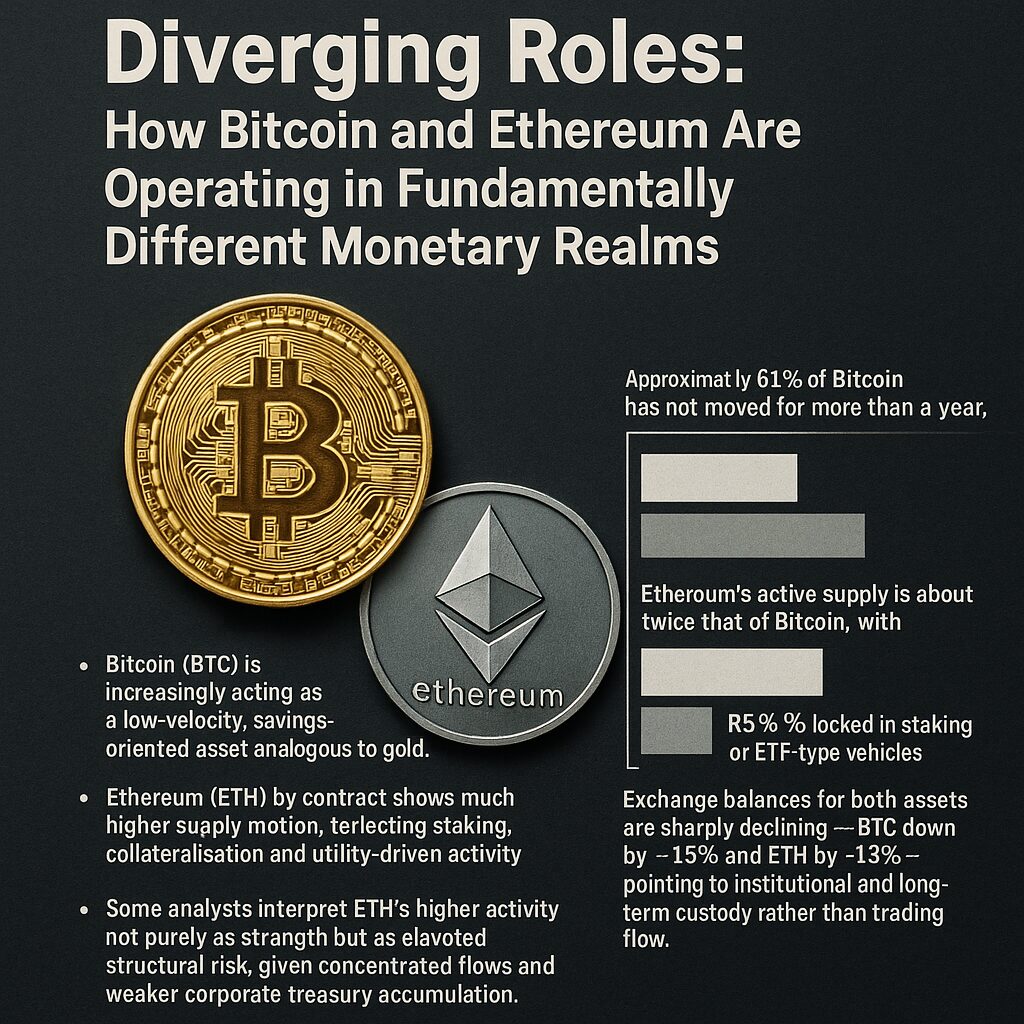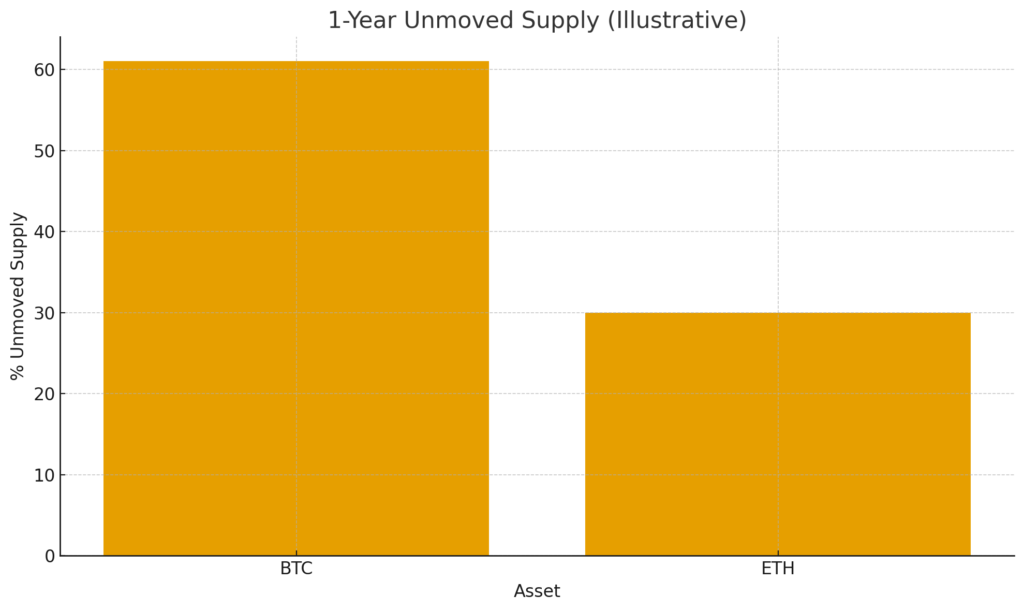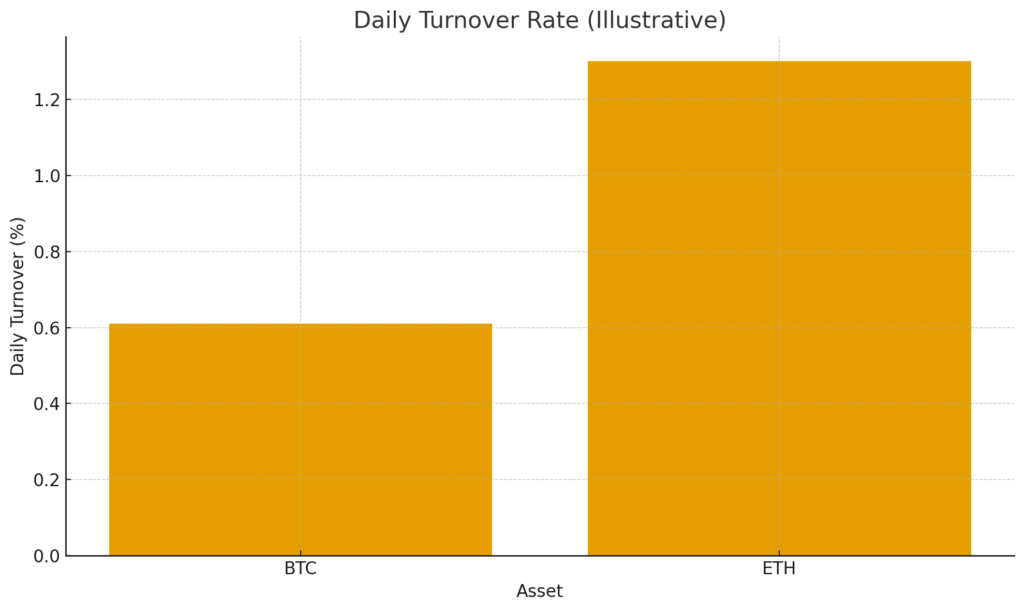
Main Points :
- Bitcoin (BTC) is increasingly acting as a low-velocity, savings-oriented asset analogous to gold.
- Ethereum (ETH) by contrast shows much higher supply motion, reflecting staking, collateralisation and utility-driven activity.
- Approximately 61% of Bitcoin has not moved for more than a year, and its daily float turnover is only ~0.61% of circulating supply.
- Ethereum’s active supply is about twice that of Bitcoin, with roughly 25% of ETH locked in staking or ETF-type vehicles.
- Exchange balances for both assets are sharply declining — BTC down by ~1.5% and ETH by ~18% — pointing to institutional and long-term custody rather than trading flow.
- Some analysts interpret ETH’s higher activity not purely as strength but as elevated structural risk, given concentrated flows and weaker corporate treasury accumulation.
1. Bitcoin as a Store-of-Value Asset

The recent joint report by Glassnode and Keyrock highlights how Bitcoin is functioning increasingly as a savings-first asset rather than a transactional currency. The data shows that around 61 % of BTC has remained unmoved for more than one year, and its daily floating supply turnover is only about 0.61 % of circulating supply — placing it among the lowest-velocity major assets globally.
This low velocity suggests BTC holders are largely taking long-term positions rather than trading frequently. In effect, Bitcoin is behaving more like digital gold, preserving value rather than driving utility or on-chain economic flows. For investors seeking an asset that can serve as a hedge or store of value, especially amid macro uncertainty, this emerging characteristic strengthens Bitcoin’s appeal.
From the perspective of someone searching for new crypto-assets or practical blockchain applications, the significance is twofold: (1) BTC’s low turnover implies a tightening supply available for trading or spending, which may support price stability or distributed accumulation; (2) however, its role as a value reservoir means that utility-driven apps or flows may favour other chains or tokens with higher throughput and activity levels.
2. Ethereum as a Utility-Driven On-Chain Engine
By contrast, Ethereum is exhibiting a markedly different profile. According to the same research, ETH’s circulating supply is about twice as active as Bitcoin’s. Approximately one-quarter of ETH is locked into staking, ETFs or other long-term vehicles.
Long-term ETH holders are moving coins at roughly three times the rate of BTC holders, and the turnover for ETH is ~1.3 % of circulating supply — over double that of Bitcoin. These patterns suggest ETH is being used more actively for utility purposes: staking, collateralising DeFi, supporting liquid-staking derivatives, and underpinning institutional wrapper products. The report frames this behaviour as “utility-driven actions rather than accumulation”.

For practitioners and investors in the blockchain space, Ethereum’s role as a productive asset gives rise to numerous opportunities. Whether it’s participating in staking yields, deploying applications on its network, or leveraging NFTs and DeFi protocols, ETH remains central to the “on-chain economy”. The fact that a sizeable portion of the supply is locked also reduces circulating float, potentially creating scarcity and upward pressure on value, particularly in a scenario of increasing protocol utilisation.
3. Declining Exchange Balances and Institutional Custody Trends

Another structural shift highlighted in the report is the rapid decline in exchange-held balances for both assets. Bitcoin’s balances are down ~1.5 %, while Ethereum’s have dropped nearly ~18 %.
These declines point to the migration of coins into institutional custody, ETFs, staking contracts, or long-term holding vehicles rather than short-term tradable supply. For Bitcoin, this reinforces its trajectory as a capital-preservation asset; a growing portion of supply is effectively removed from daily circulation. For Ethereum, the flow into staking and institutional products underscores its utility focus and the embedding of ETH into financialised blockchain infrastructure.
For new crypto-asset seekers, the implication is that competition for attention and capital may intensify among alt-chains or layer-2s that attempt to capture the “utility” side of the split. Assets that offer high throughput, real-world use cases and yield-generating features could benefit from an ecosystem where ETH anchors the infrastructure layer and liquidity becomes more concentrated in fewer hands.
4. Interpreting the Divergence — Opportunities and Risks
Opportunity Lens
From an investment and application standpoint, the bifurcation between Bitcoin and Ethereum suggests two distinct risk/reward zones. Bitcoin offers relative stability and a hedge narrative — ideal for conservative asset allocation or treasury reserves in crypto-native setups. Ethereum — with its high activity, staking incentives and institutional integration — appeals to growth-orientated investors and builders seeking yield, application volume and protocol expansion.
For instance, staking ETH or participating in layer-2 ecosystems might generate higher yield and greater upside, albeit with higher risk. Meanwhile, holding BTC may offer lower volatility but potentially lower upside in terms of utilisation growth. This duality means crypto-portfolio construction could benefit from combining the two: stability plus growth.
Risk-Adjustment Perspective
However, the divergence also introduces risks. Some analysts flag that Ethereum’s high velocity and concentration of flows may actually elevate structural vulnerability. For example, 10x Research notes that firms heavily centred on ETH may face weaker capital cushions and that the narrative of “digital-asset treasury accumulation” is less robust for ETH than for BTC.
Furthermore, if ETH is being used heavily for operational utility (staking, DeFi) but not as widely accepted as a value store, a downturn in on-chain activity could hit it harder than Bitcoin. This suggests that applicative success does not guarantee resilience in a stress scenario. Meanwhile, BTC’s slower motion means fewer catalysts for dramatic growth beyond macro-asset flows or infrastructural adoption.
5. Strategic Considerations for New Crypto Assets and Builders
Given this analysis, what should practitioners and investors seeking next-generation crypto opportunities consider?
- Utility-First Protocols: Assets that mirror Ethereum’s trajectory — heavy on staking, DeFi usage, institutional wrappers — may gain momentum. Look for chains or tokens with measurable on-chain activity, locked supply and yield mechanics.
- Value-Preservation Alternatives: Conversely, protocols positioning themselves as digital gold alternatives (silver to Bitcoin’s gold) may tap into the store-of-value narrative. Lower turnover, long-term holdings and custodial accumulation could be signals.
- Ecosystem Layering: Recognise that Bitcoin and Ethereum may anchor separate monetary zones; new assets may either aim to sit within the Ethereum ecosystem (utility layer) or carve out a different niche. Understanding where a token sits on the “value-versus-utility” axis is key.
- Liquidity and Institutional Flows: Monitor exchange balances, staking contracts and ETF flows. If tokens are being locked and removed from tradable supply, scarcity can drive value but also increase centralisation risk.
- Risk Management: For builders and investors, the structural features matter. High turnover and locked supply create opportunities — but also dependencies. If protocol activity falters, utility tokens may face steeper corrections. Value-store assets may have fewer growth levers.
6. Summary and Conclusion
In summary, the recent study from Glassnode and Keyrock paints a clear picture: Bitcoin and Ethereum are diverging into fundamentally different monetary and functional zones. Bitcoin is becoming more of a savings vehicle — a low-velocity, store-of-value asset with a long-term holder base. Ethereum, by contrast, is evolving into a high-activity, utility-driven engine of staking, collateral and DeFi infrastructure.
For investors and builders in the blockchain space, this implies a strategic bifurcation: one lane for value preservation and another for growth through on-chain utility. New crypto assets should be evaluated not just on hype or tokenomics, but on where they sit in this continuum and how they capture activity, lock-up and institutional participation.
Ultimately, the cryptocurrency ecosystem is maturing and differentiating. Recognising which zone a token or protocol occupies — and the implications for supply dynamics, liquidity, institutional flows and risk-adjusted return — will help those seeking the next revenue source or practical blockchain application to navigate the space with more informed intention.

